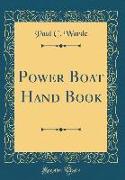- Start
- Power Boat Hand Book (Classic Reprint)
Power Boat Hand Book (Classic Reprint)
Angebote / Angebote:
Excerpt from Power Boat Hand BookOur engine, since starting, has been well throttled down, as there is really no use having it race away, wearing itself out for nothing, besides the shake and jar on the boat. Before putting in the clutch we speed up just a little, just enough not to stall the motor and then press in the clutch. Don't jam it in. Just press it up to the point where a little more effort will make it 'take hold and lock.We carefully steer out between the other boats and head for our black buoy, just in time to meet another boat coming in. We get one whistle from this incoming boat which we answer with one whistle and turn our boat to the right, enough to allow a safe distance between us and the incoming boat which has also turned somewhat to the right to give us part of the channel. We pass the black buoy to starboard (our right side, as buoys have no port nor starboard, we must learn that the term pass to starboard, or pass to port, refers to the boat's side and not the buoy's) and head full speed for the lighthouse some couple of _miles away.Now if we only had a chart aboard we could learn just how near that light we could go, whether the bottom was soft or rocky, whether the light was a white light or a red light. The paint on a lighthouse of course does not tell us the color of the light, but nevertheless if we had the Government book aboard called the Light List we would find this lighthouse is described with many other lights for this district. So on our return we had better make out a list of things we really should have. We hold well off the light not knowing what else to do, and keep on until we come to another black buoy. Should this also bepassed on the starboard? Now this is when and where we need a chart. Our good friend at the club is some miles away, but if we had a chart of the locality we would be independent. We therefore decide to turn back, receiving two sharp blasts from a large steamer which turned somewhat up to the left and passed close to us on our right hand or starboard side. We thereby learn that it is necessary for us to know what these whistles mean, and when and how they are to be used and given. Before we reach Our club anchorage, we cut down our speed about half, as it is bad form to go rushing through a ¿eet of boats or narrow channels full speed. As we near our mooring we give it a wide berth as we pass, then turn about, head our boat up against the tide and straight for our pickup buoy. Throwing out the clutch and slowly coming up in reach Of the buoy we pick up our line (with the boat hook, which we keep well forward and ready for this purpose) and make the line fast to the deck cleat.About the PublisherForgotten Books publishes hundreds of thousands of rare and classic books. Find more at www.forgottenbooks.comThis book is a reproduction of an important historical work. Forgotten Books uses state-of-the-art technology to digitally reconstruct the work, preserving the original format whilst repairing imperfections present in the aged copy. In rare cases, an imperfection in the original, such as a blemish or missing page, may be replicated in our edition. We do, however, repair the vast majority of imperfections successfully, any imperfections that remain are intentionally left to preserve the state of such historical works.
Folgt in ca. 10 Arbeitstagen
